
According to the results of a survey conducted by Active Group and Experts Club in August 2025, Ukrainians tend to have a positive attitude toward Israel.
Thus, 44.7% of respondents expressed sympathy for this country (32.7% — mostly positive, 12% — completely positive). Negative assessments accounted for 13.7%, another 40% remained neutral, and 1.7% admitted that they did not know enough about Israel.
“Despite a certain percentage of criticism, Ukrainians’ attitude toward Israel remains generally positive. This is explained by both historical ties and cooperation in the fields of medicine, science, and military technology,” commented Active Group CEO Oleksandr Pozniy.
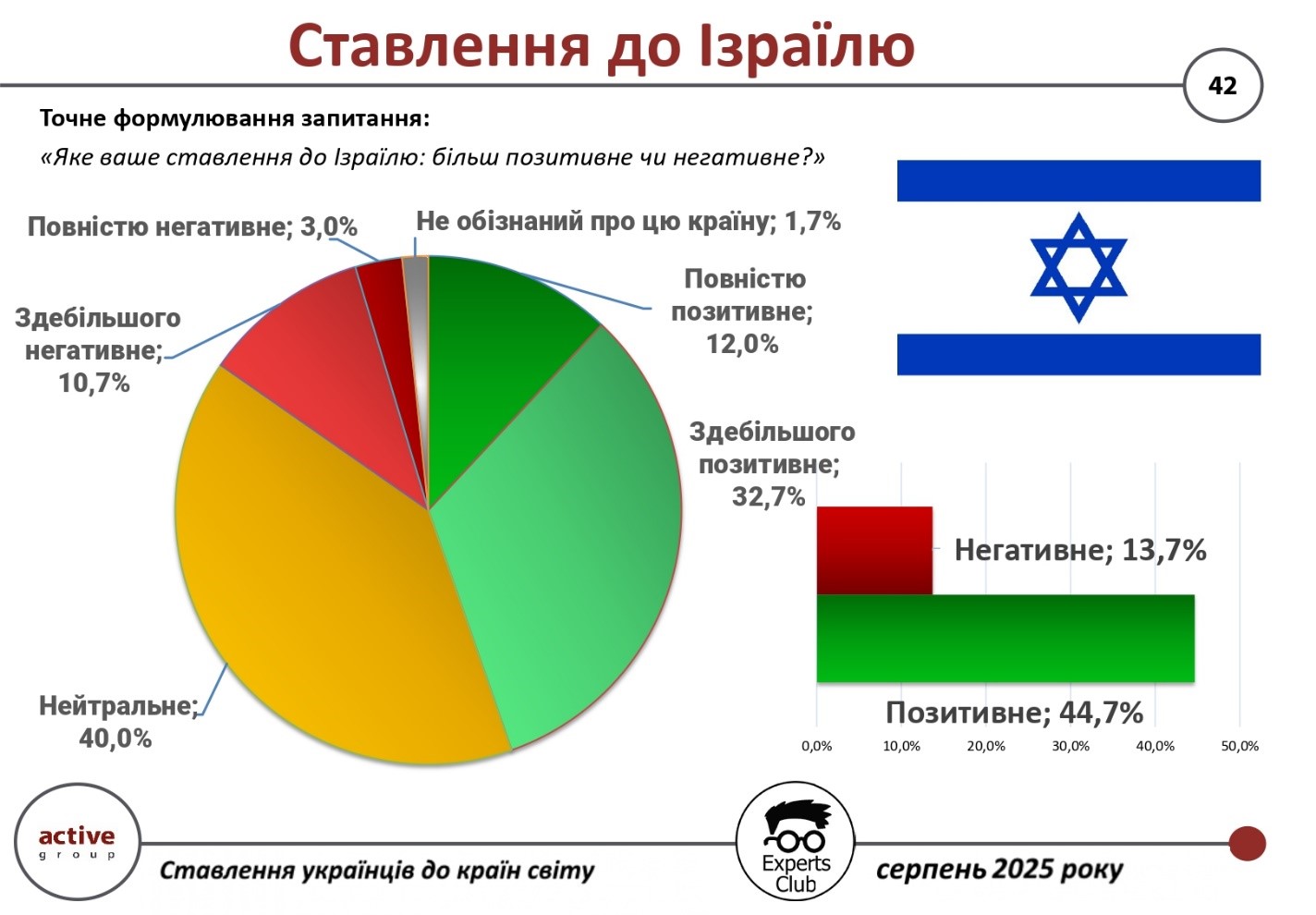
In turn, Maksim Urakin, co-founder of Experts Club, drew attention to the trade and economic component:
“At the end of 2025, bilateral trade between Ukraine and Israel amounted to more than $353 million. Ukrainian exports amounted to $132.4 million, while imports of Israeli goods exceeded $221 million. This led to a negative balance of about $88.6 million. Such an imbalance indicates the need to expand Ukrainian exports and search for new niches in the Israeli market,” he stressed.
Thus, Ukrainians’ attitude toward Israel is moderately positive, but economic indicators show challenges that should be taken into account in bilateral relations.
The full video can be viewed at: https://www.youtube.com/watch?v=YgC9TPnMoMI&t
You can subscribe to the Experts Club YouTube channel here: https://www.youtube.com/@ExpertsClub
ACTIVE GROUP, EXPERTS CLUB, ISRAEL, Pozniy, SOCIOLOGY, TRADE, UKRAINE, URAKIN
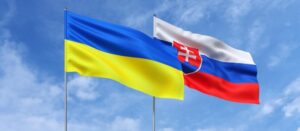
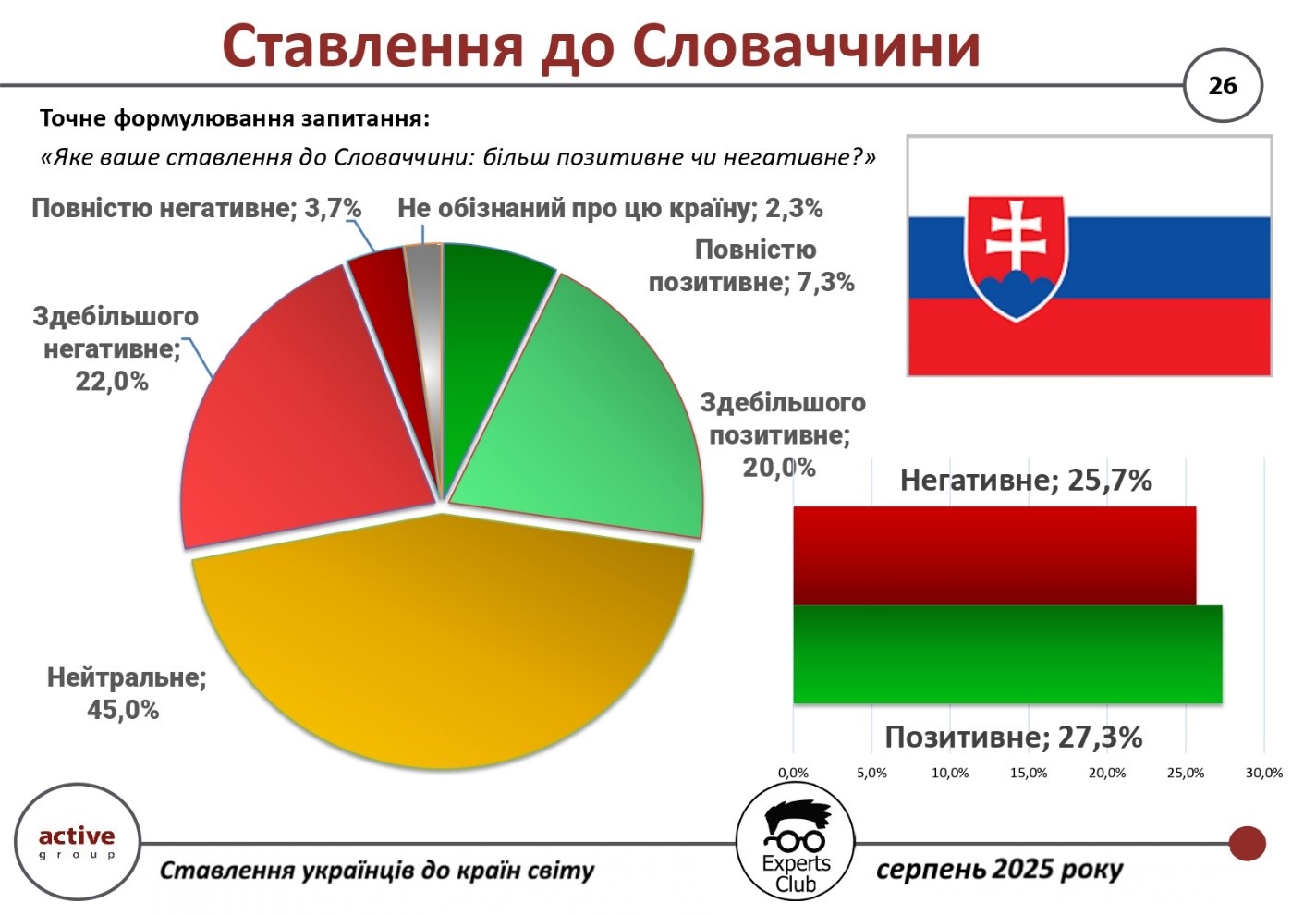
A sociological survey conducted by Active Group in cooperation with the Experts Club think tank in August 2025 showed that Ukrainians’ attitudes toward Slovakia are quite controversial.
According to the results, 27.3% of respondents demonstrated a positive attitude toward this country (20.0% – mostly positive, 7.3% – completely positive). At the same time, 25.7% of Ukrainians expressed a negative opinion (22.0% – mostly negative, 3.7% – completely negative). A significant part of citizens – 45.0% – remain neutral, and another 2.3% said they do not have enough information about Slovakia.
“We observe a kind of balance between positive and negative perceptions of Slovakia. On the one hand, there is historical and geographical proximity, cultural contacts, and on the other hand, tense moments in the political dialogue in recent years. This creates an ambiguous picture,” explained Oleksandr Poznyi, co-founder of Active Group.
In his turn, Maksym Urakin, founder of Experts Club, drew attention to the economic dimension of bilateral relations.
“In the first half of 2025, the trade turnover between Ukraine and Slovakia amounted to more than $1.48 billion. At the same time, exports from Ukraine amounted to $483.7 million, while imports from Slovakia amounted to almost $999.1 million. The negative balance of more than $515 million indicates an imbalance in trade, which also affects the public perception of the country,” he emphasized.
The survey was part of a broader study of international sympathies and antipathies of Ukrainians in the current geopolitical context.
The full video can be viewed here:
https://www.youtube.com/watch?v=YgC9TPnMoMI&t
You can subscribe to the Experts Club YouTube channel here:
https://www.youtube.com/@ExpertsClub
ACTIVE GROUP, DIPLOMACY, EXPERTS CLUB, Poznyi, SLOVAKIA, SOCIOLOGY, TRADE, URAKIN

Most Ukrainians have a positive opinion of Azerbaijan, according to the results of a survey conducted by Active Group in collaboration with the Experts Club think tank.
According to the study, 56.7% of Ukrainians expressed a positive attitude toward Azerbaijan, of which 15.3% were completely positive and 41.3% were mostly positive. Only 5.7% of respondents expressed a negative attitude (1.0% completely negative, 4.7% mostly negative). A neutral position was taken by 36.3% of respondents, while another 1.3% said they were not familiar with the country.
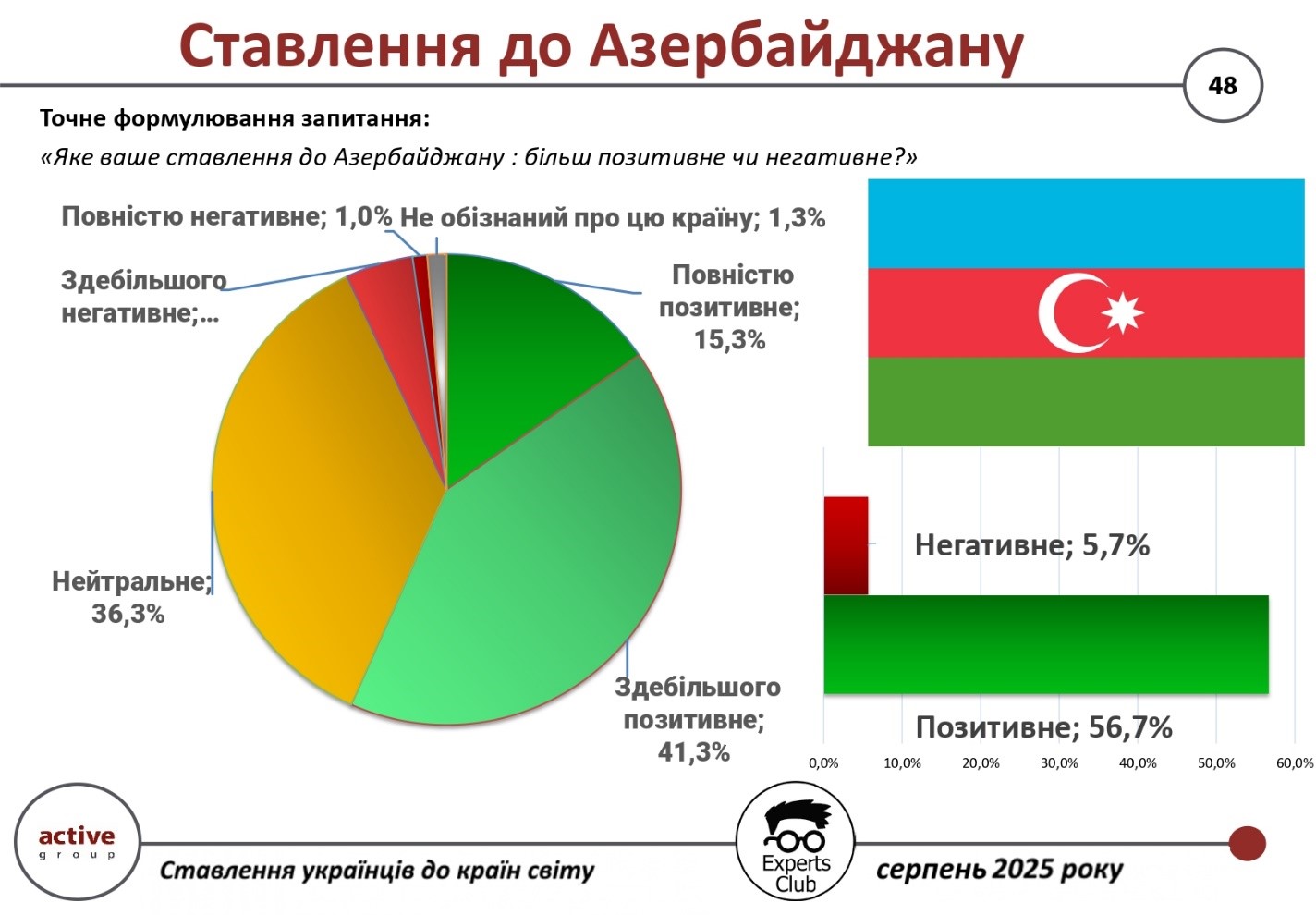
“Ukrainians have a favorable attitude toward Azerbaijan, given the close cultural and historical ties, as well as active cooperation in the energy and transport sectors,” emphasized Alexander Pozniy, head of Active Group.
In turn, Experts Club co-founder Maxim Urakin stressed the importance of trade and economic cooperation, which has continued to develop rapidly in recent years.
“According to the results of the first months of 2025, trade turnover between Ukraine and Azerbaijan amounted to $237.9 million. Ukrainian exports reached $110.3 million, while imports amounted to $127.6 million. The negative balance amounted to $17.3 million, which is relatively small compared to other countries, but confirms the activity of mutual trade flows.”
Thus, Azerbaijan remains a reliable partner of Ukraine in both social and economic terms, and the level of trust among Ukrainians remains high.
The full video can be viewed at: https://www.youtube.com/watch?v=YgC9TPnMoMI&t
You can subscribe to the Experts Club YouTube channel here: https://www.youtube.com/@ExpertsClub
ACTIVE GROUP, AZERBAIJAN, EXPERTS CLUB, Pozniy, SOCIOLOGY, TRADE, UKRAINE, УРАКИН

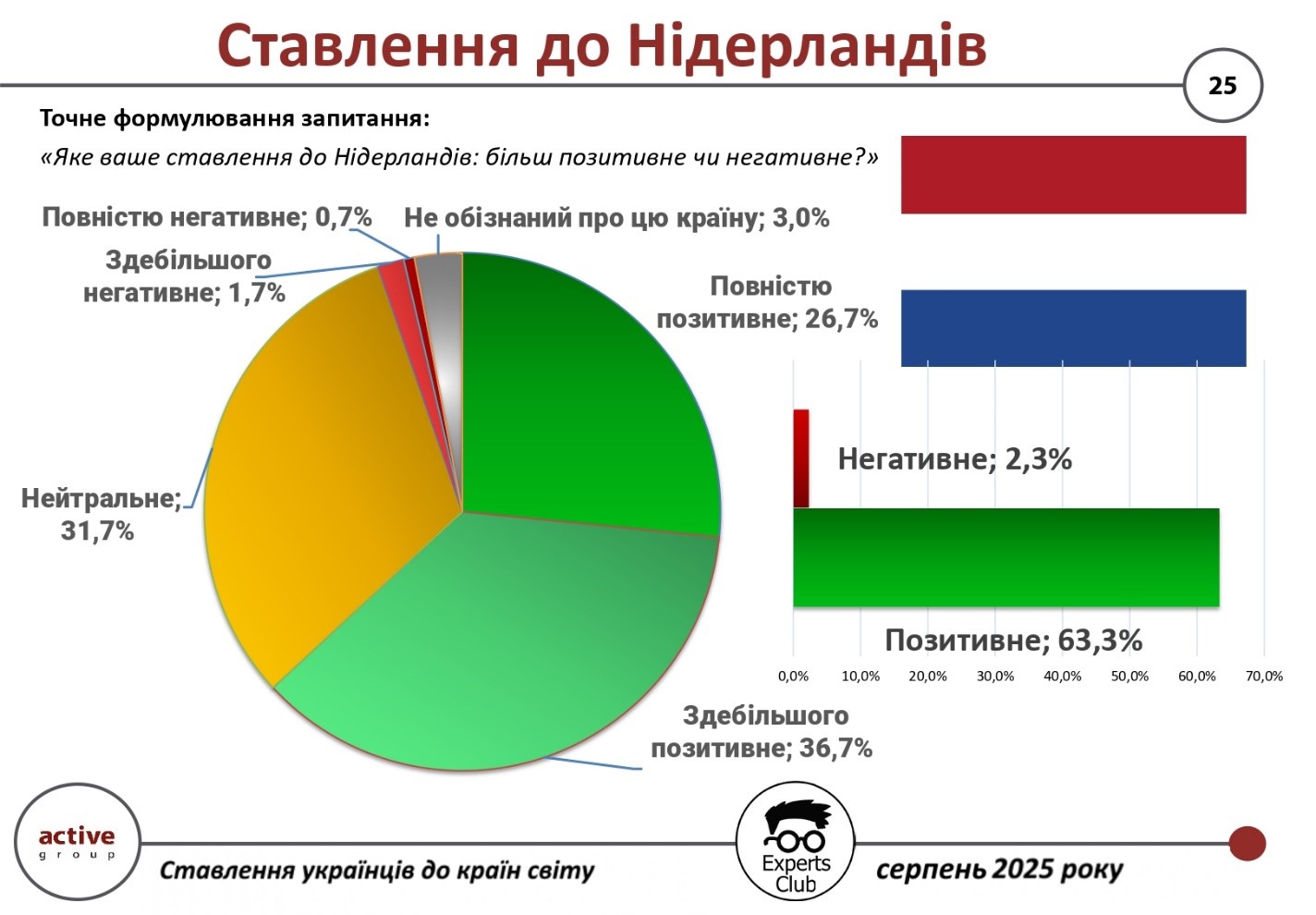
The Netherlands ranks high in the rating of Ukrainians’ sympathies, demonstrating a consistently positive image among citizens. This is evidenced by the results of an all-Ukrainian survey conducted by Active Group in cooperation with the Experts Club information and analytical center in August 2025.
According to the study, 63.3% of Ukrainians have a positive attitude towards the Netherlands (36.7% – mostly positive, 26.7% – completely positive). Only 2.3% of respondents expressed a negative attitude (1.7% – mostly negative, 0.7% – completely negative). Another 31.7% of citizens are neutral, and 3.0% said they are not sufficiently aware of this country.
“The Netherlands is one of Ukraine’s most important trading partners in the European Union. In the first half of 2025, the volume of bilateral trade amounted to almost $ 1.48 billion, of which exports from Ukraine amounted to more than $ 918 million and imports from the Netherlands – $ 561 million. The positive balance of $357 million is evidence that Ukraine has favorable positions in cooperation with this country,” said Maksym Urakin, founder of Experts Club.
In his turn, Alexander Poznyi, co-founder of Active Group, emphasized that the positive attitude of Ukrainians is complex.
“The Netherlands is known as a country that supports Ukraine in the international arena and participates in humanitarian and financial assistance programs. At the same time, long-term cultural and educational contacts strengthen the positive image of this country in Ukrainian society. That is why almost two-thirds of citizens show favorable attitudes, and the negative segment remains minimal,” he added.
The survey was part of a broader study of international sympathies and antipathies of Ukrainians in the current geopolitical environment.
The full video can be viewed here:
https://www.youtube.com/watch?v=YgC9TPnMoMI&t
You can subscribe to the Experts Club YouTube channel here:
https://www.youtube.com/@ExpertsClub
ACTIVE GROUP, DIPLOMACY, EXPERTS CLUB, NETHERLANDS, Poznyi, SOCIOLOGY, TRADE, URAKIN

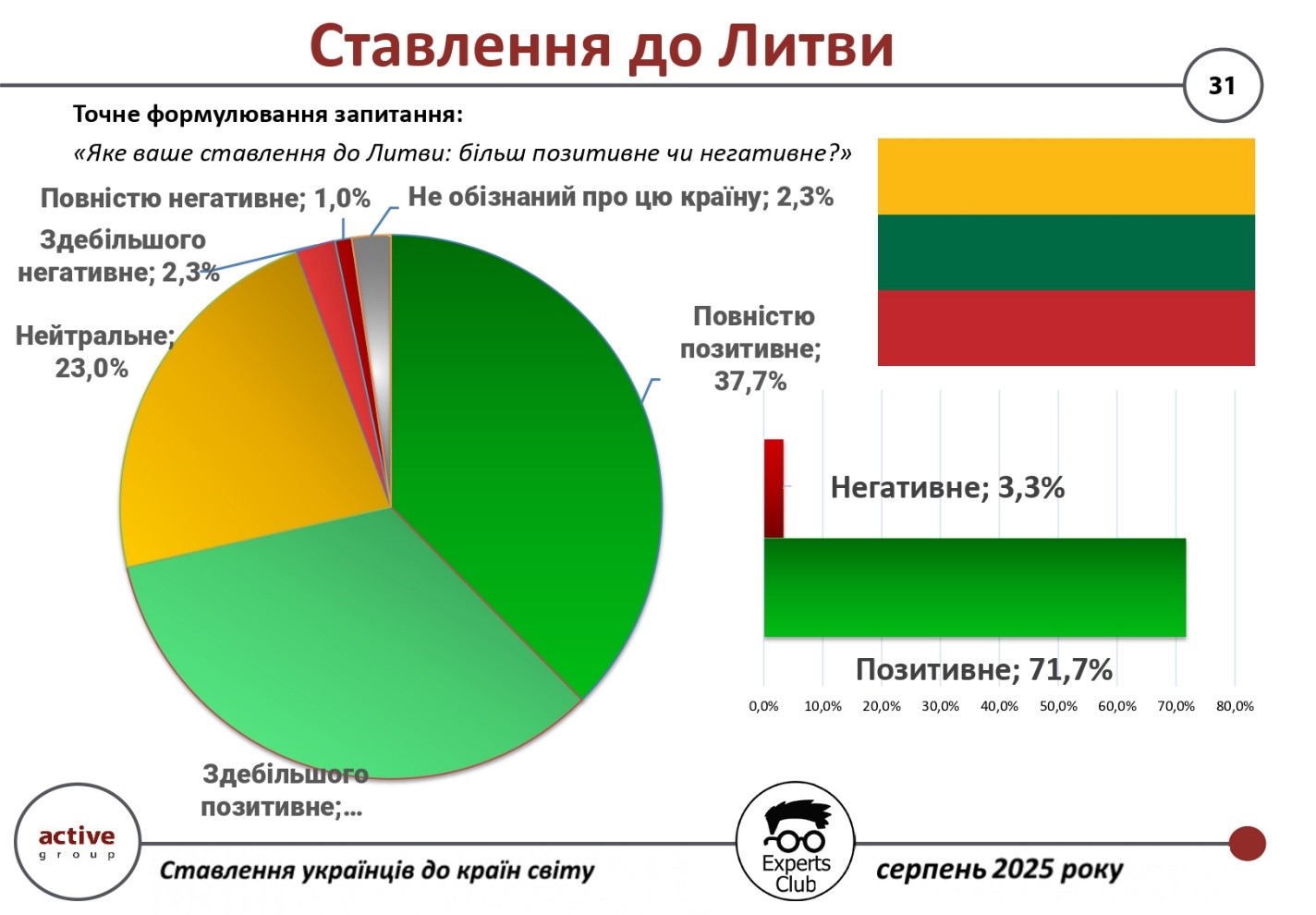
Lithuania remains one of the most positively perceived countries among Ukrainian citizens. This is evidenced by the results of an all-Ukrainian sociological survey conducted by Active Group in cooperation with the Experts Club information and analytical center in August 2025.
According to the survey, 71.7% of Ukrainian citizens have a positive attitude towards Lithuania (34.0% – mostly positive, 37.7% – completely positive). Only 3.3% of respondents expressed a negative attitude (2.3% – mostly negative, 1.0% – completely negative). At the same time, 23.0% of Ukrainians remain neutral, and 2.3% admitted that they do not have enough information about this country.
“For Ukrainians, Lithuania is a symbol of true friendship and unconditional support. The high level of positive assessments is the result of active political, military and humanitarian assistance from Vilnius during the war,” said Oleksandr Poznyi, co-founder of Active Group.
In turn, Maksym Urakin, founder of Experts Club, emphasized the economic component of relations between the two countries:
“In the first half of 2025, trade between Ukraine and Lithuania exceeded $988 million. At the same time, Ukrainian exports amounted to almost $348 million, while imports from Lithuania reached more than $640 million. The negative balance of about $293 million indicates Ukraine’s dependence on Lithuanian supplies,” he emphasized.
The survey was part of a broader program of research on international sympathies and antipathies of Ukrainians in the context of modern geopolitics.
The full video can be viewed here:
https://www.youtube.com/watch?v=YgC9TPnMoMI&t
You can subscribe to the Experts Club YouTube channel here:
https://www.youtube.com/@ExpertsClub
ACTIVE GROUP, DIPLOMACY, EXPERTS CLUB, LITHUANIA, Poznyi, SOCIOLOGY, TRADE, URAKIN

According to the results of a study conducted by Active Group and Experts Club in August 2025, Ukrainians express a predominantly neutral or moderately positive attitude toward Saudi Arabia.
According to the survey, 61.2% of respondents have a neutral attitude toward this country. A positive assessment was given by 24.8% of respondents (3.3% — completely positive, 22.5% — mostly positive). A negative attitude was expressed by 11.0% of Ukrainians (3.4% — completely negative, 9.6% — mostly negative), while 7.0% admitted that they were not familiar enough with the country.
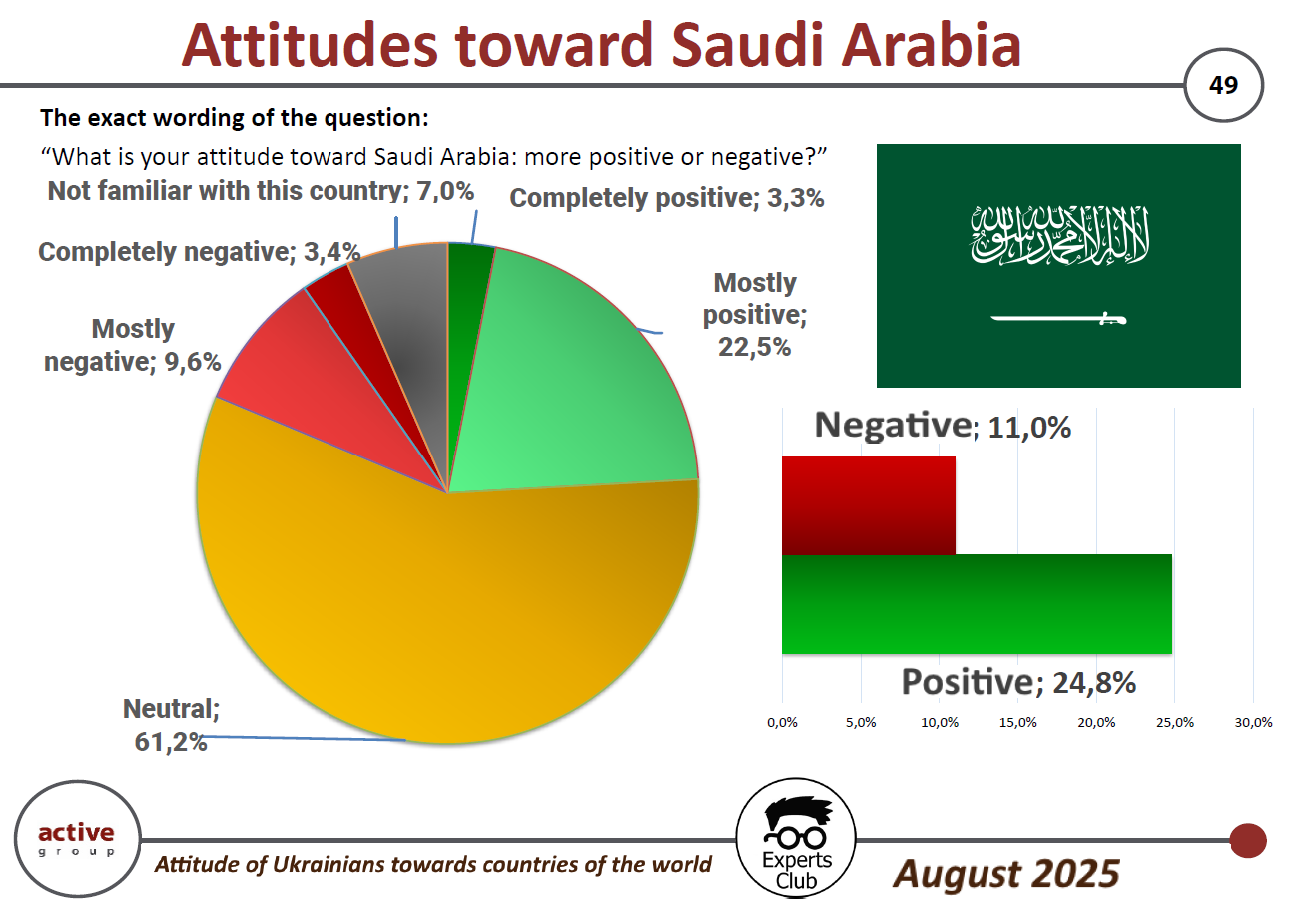
“Saudi Arabia is perceived by Ukrainians as a distant and little-known partner. At the same time, the positive assessment of more than a quarter of respondents indicates interest in cooperation and openness to the development of relations,” commented Active Group Director Oleksandr Pozniy.
Experts Club co-founder Maksym Urakyn emphasized the economic aspect:
“In 2025, trade turnover between Ukraine and Saudi Arabia reached $287.2 million. At the same time, exports from Ukraine amounted to $207.8 million, while imports amounted to only $79.4 million, resulting in a positive balance of $128.4 million. This is one of the most balanced areas for Ukraine, especially in the field of agricultural products,” he said.
The survey was part of a large-scale project by Active Group and Experts Club to study Ukrainians’ attitudes toward countries around the world.
ACTIVE GROUP, EXPERTS CLUB, international relations, Pozniy, SAUDI ARABIA, SOCIOLOGY, TRADE, UKRAINE, УРАКИН